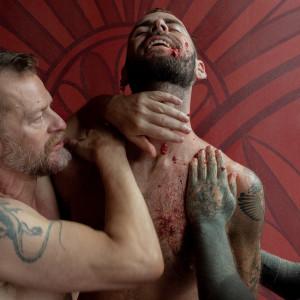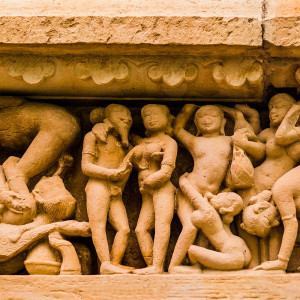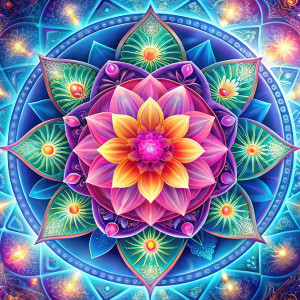Neo-Tantra: a brief overview
Introduction
Neo-Tantra, also known as the ‘neo-Tantric movement’, is a modern Western interpretation and further development of traditional Tantric teachings and sexual practices that did not serve reproduction, which were observed in some ancient Near Eastern cultures.
Neotantra has developed in the Western world into a movement that combines sexuality and spiritual practices.

The term Neotantra – origin and development
The term ‘Neotantra’ refers to a modern form of Tantric teachings that are mainly applied in the West. This term is rarely used by the followers of the corresponding movements themselves and has been established since at least 1979. Some roots of Neotantra lie in classical Tantra, which is deeply interwoven with Hindu and Buddhist traditions. In the 20th century, Western authors and spiritual teachers began to popularise and reinterpret Tantric teachings. Among the most famous figures of the early Neotantra movement are the Indian Osho and the American Pierre Bernard. Both contributed significantly to the spread of Tantric ideas in the West by adapting traditional practices to Western ideas and needs.
Basic principles
Neotantra places a strong emphasis on the connection between sexuality and spirituality. In contrast to Western views, which often regard sexuality as purely physical, Neotantra sees sexual energy as a significant force that can lead to spiritual enlightenment. The main principles of Neotantra include mindfulness, a deep emotional and physical connection between partners, and the recognition and cultivation of sexual energy as a path to personal and spiritual development.
Practices
Neotantra practices are diverse and include breathing exercises, meditation, yoga, and special techniques of touch and sexual techniques. A central element is the so-called ‘tantric union’, in which partners connect in a profound way and consciously direct and increase their sexual energy. These practices aim to expand consciousness, release emotional blockages and experience a deeper sense of unity and harmony.
Criticism and controversy
Neotantra is not free from criticism and controversy. Some critics complain about the commercial exploitation of Tantric teachings and the simplification of complex spiritual practices for the Western market. In addition, the legitimacy of the teachings is occasionally questioned, since many Neotantra practitioners have not received in-depth training in traditional Tantric disciplines.
Influence and prevalence
Despite the criticism, Neotantra has found a wide following worldwide and influences many aspects of modern spiritual and sexual culture. Seminars , workshops and retreats that teach Neotantric practices are widespread and often well attended. Neotantra has also left its mark on psychotherapy and sexual health, where it is seen as a tool for improving intimacy and well-being.

Differences between traditional Tantra and Neotantra
There are several characteristic differences between traditional Tantra in the Indian context and Neotantra as practised in Western societies:
· Access and practice: Traditional Tantra is a secret doctrine to which only a few initiates have access. These must undergo a lengthy, demanding process of spiritual self-realisation that requires years of intensive study and practice. In contrast, Neo-Tantra is offered in a much broader form, both in publications on the general book market and in workshops and courses that are open to everyone.
Role of orgasm: While in traditional Tantra orgasm, especially male orgasm, does not play a central role and is usually withheld, in Neo-Tantra it is often desired and is even considered a goal. Neotantra emerged at a time when the enlightened population of Western civil society had already fought for and gained a great deal of freedom for individual development through numerous liberal, spiritual, political, emancipatory and scientific processes. The neotantric ritual therefore primarily aims at experiencing intimacy and pleasure, rather than at spiritual transformation through restraint.
Objectives and practice: The ultimate goal of traditional Tantra is spiritual elevation and the transcendental union of the male and female principles. The mithuna ritual is less about lust and more about achieving bliss by silencing the mind and allowing consciousness to be fulfilled solely by the experience of existence itself. In Neo-Tantra, on the other hand, bliss is often associated with an intense state of sensual pleasure. This kind of ‘sacred’ or ‘oceanic’ sex, in which the awareness of one's own bodily limits is temporarily suspended at the moment of orgasm – with or without an actual orgasm – represents a deviation from traditional Tantra. Tantra seminars
Since the 1990s, a well-connected Tantra scene has emerged in Germany, which has formed around various Tantra schools. About 15 to 20 providers run a variety of different workshops and seminars.

Social classification of neo-Tantra
The Tantra scene is historically rooted in the tradition of esotericism and can be assigned to both the New Age movement and the new social movements. There is also an overlap with the alternative scene and the polyamory subculture. Its basic idea: people with fulfilled sexuality can enjoy their lives more freely and are less susceptible to political extremism.
Political links exist in particular to ZEGG (Centre for Experimental Cultural Design in Belzig) and to parts of the lesbian scene. Nevertheless, a large part of the Tantra movement remains rather apolitical.
Despite the great importance of erotic and sexual rituals in Neo-Tantra, there is little overlap with the swinger scene. Compared to the latter, the Tantra scene is relatively small.
Conclusion
Neo-Tantra represents a significant movement within the Western spiritual scene that reinterprets traditional Tantric teachings and ancient Near Eastern sources and adapts them to modern needs. Despite criticism and controversy, Neo-Tantra offers many people a way to experience sexuality and spirituality in a profound and transformative way. It remains a vibrant and dynamic field that is constantly growing and evolving.
Overall, the article ‘Neotantra’ on the German Wikipedia provides a comprehensive overview of the origins, principles, practices, critiques and influence of this movement.
How did Neotantra come to the gay world?
Neotantra found its way into the gay world mainly in the late 1980s and early 1990s, when spiritual and sexual movements were increasingly gaining ground. Gay men, often confronted with societal norms and ideas of sexuality and intimacy, were looking for ways to connect their sexuality with spiritual experiences. Tantra offered them the opportunity to understand sexual energy as a transformative, healing force, integrating the themes of mindfulness, connection and awareness. Body Electric, one of the best-known organisations promoting Neo-Tantra for gay men, played a key role in establishing Tantric elements as a tool for sexual healing and consciousness work.
The importance of Body Electric for Neo-Tantra for gay men in Europe
Body Electric is an organisation that was founded in the United States in the 1980s that specialises in offering Tantra and bodywork to gay men. In Europe, Body Electric has been very well received by gay men, particularly in the UK and Germany, and has helped to spread Neo-Tantra in the gay community. Their retreats and workshops emphasise the connection between body awareness, sexual energy and spiritual practice, and promote an integrative attitude towards sexuality. The work of Body Electric has had a lasting influence on the Western Neo-Tantra movement for gay men, particularly in terms of its acceptance of sexuality as a sacred and healing practice. See also the article on the history of Bodyelectric Europe and Gay Love Spirit.




